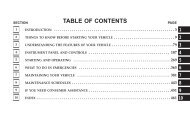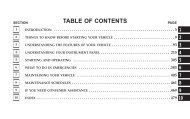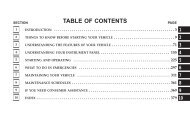8W-01 WIRING DIAGRAM INFORMATION
8W-01 WIRING DIAGRAM INFORMATION
8W-01 WIRING DIAGRAM INFORMATION
Create successful ePaper yourself
Turn your PDF publications into a flip-book with our unique Google optimized e-Paper software.
HB <strong>8W</strong>-<strong>01</strong> <strong>WIRING</strong> <strong>DIAGRAM</strong> <strong>INFORMATION</strong> <strong>8W</strong> - <strong>01</strong> - 9<br />
WARNING: Do not allow flame or sparks near the battery. Gases are always present in and around the battery.<br />
WARNING: Always remove rings, watches, loose hanging jewelry and avoid loose clothing.<br />
DIAGNOSIS AND TESTING - <strong>WIRING</strong> HARNESS<br />
TROUBLESHOOTING TOOLS<br />
When diagnosing a problem in an electrical circuit there are several common tools necessary. These tools are listed<br />
and explained below.<br />
• Jumper Wire - This is a test wire used to connect two points of a circuit. It can be used to bypass an open in<br />
a circuit.<br />
WARNING: Never use a jumper wire across a load, such as a motor, connected between a battery feed and<br />
ground.<br />
• Voltmeter - Used to check for voltage on a circuit. Always connect the black lead to a known good ground and<br />
the red lead to the positive side of the circuit.<br />
CAUTION: Most of the electrical components used in today’s vehicles are Solid State. When checking voltages<br />
in these circuits, use a meter with a 10 - megohm or greater impedance rating.<br />
• Ohmmeter - Used to check the resistance between two points of a circuit. Low or no resistance in a circuit<br />
means good continuity.<br />
CAUTION: Most of the electrical components used in today’s vehicles are Solid State. When checking resistance<br />
in these circuits use a meter with a 10 - megohm or greater impedance rating. In addition, make sure<br />
the power is disconnected from the circuit. Circuits that are powered up by the vehicle’s electrical system<br />
can cause damage to the equipment and provide false readings.<br />
• Probing Tools - These tools are used for probing<br />
terminals in connectors. Select the proper size<br />
tool from Special Tool Package 6807, and insert<br />
the probing end (2) into the terminal being<br />
tested. Use the other end of the tool (1) to insert<br />
the meter probe.<br />
INTERMITTENT AND POOR CONNECTIONS<br />
Most intermittent electrical problems are caused by faulty electrical connections or wiring. It is also possible for a<br />
sticking component or relay to cause a problem. Before condemning a component or wiring assembly, check the<br />
following items.<br />
• Connectors are fully seated<br />
• Spread terminals, or terminal push out<br />
• Terminals in the wiring assembly are fully seated into the connector/component and locked into position<br />
• Dirt or corrosion on the terminals. Any amount of corrosion or dirt could cause an intermittent problem<br />
• Damaged connector/component casing exposing the item to dirt or moisture<br />
• Wire insulation that has rubbed through causing a short to ground<br />
• Some or all of the wiring strands broken inside of the insulation<br />
• Wiring broken inside of the insulation

















